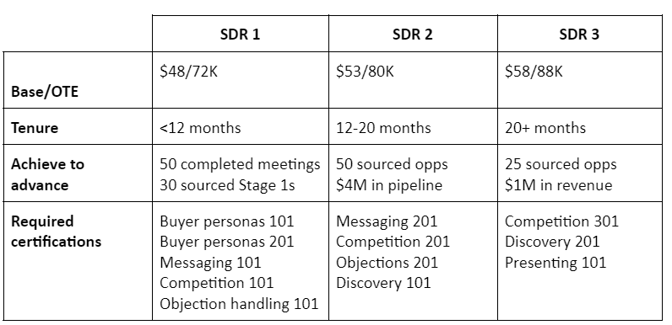Last month, I just put together a presentation for a handful of VC-backed portfolio companies on building attrition into SDR planning. The broader topic was what happens to your 2024 SDR pipeline number if your quit rate spikes. You can watch a shorter video version of the talk here.
For many companies in the audience, the SDR operating plan was built off of 2023. “We did $20M new logo ARR last year, want to grow by 30%, goal for this year is $26. We need sales development to source 25% of that so we need 2 more SDRs.”
This is a very common aspect of the headcount planning process but what is often overlooked are the underlying assumptions of rep attrition. If 2024 attrition mirrors 2023, no problem. But what if it doesn’t? And is that even a reasonable expectation?
Turning to the BLS Quits Data
We’re coming off of 15 months of the lowest quit rate that we’ve seen in a decade. With layoffs being broadly publicized and stiffer market conditions keeping people in role longer, voluntary attrition (aka quits) dropped significantly during Q4’22-Q4’23.
We have clients who had 25-35% attrition in 2023. That is outstanding. Normally, we’d anticipate that number to be 40-50%. (See our SDR research data below for historical context.)

But what happens if 2024 regresses to the mean of what we’ve seen over the past 10 years?
Let’s run a thought experiment
Let’s assume a fully ramped SDR sources 5 Stage 1 Opptys per month with a $50K ACV (~$3M in pipeline annually).
For each seat that quits, we have to post, interview, offer, start, and ramp to get back to what we lost. While current SDR roles are being flooded with applications, that wasn’t always the case and may not be going forward. Even with all of those applicants, the time to fill still often sits around 25-30 days.
The visual below shows a 10 person team and models 2024 attrition returning to the long-term trend of ~50%. Each white box is the month a rep turns over and the seat is filled while the green gradient shows their performance during the ramp period. In this model, the team misses the 2024 number by 11%.
Calculating the impact of attrition for your team
Here’s what you need:
- Your time to fill in months (think: from prior rep’s last day to new hire’s first)
- Average ramp time (since 2007 this has been 3 months +/- 2 weeks)
- Your 2024 anticipated attrition rate (quits, fires, and internal promotions)

Using this back-of-napkin math, you can model different scenarios to understand where your team will land against the 2024 number. More importantly, doing this now gives you 10+ months to adjust before it’s too late and 2024 is a miss.
Actions you can take
Now that we’ve detailed the issue and how to calculate it, what can you do about it?
Option 1: Hire ahead of attrition
If you have a 10 person team and are anticipating being 10% under production expectations, that is 1 full additional headcount! If you have the ability to, hire more reps now and let attrition naturally right size your team over the course of the year. If you have modeled the attrition expectations into your plan, no need to constantly readjust unless your 2 variables (Ramp + fill, attrition rate) start to move outside calculated expectations.
Not everyone can just go change their SDR team’s headcount and open more reqs. So if the headcount is outside of your control, what can you do?
Option 2: Shape not shorten ramp time
Sounds lovely, but how? Break the impact (shown above) down into its component parts.
Time to fill - Reduce the time your SDR seat is empty to as close to 0 days as possible. Always be interviewing. Create and nurture a pipeline of talent that you can reengage as soon as you have an open req. Network in your area, reach out to past applicants, create relationships with universities (especially those with a sales program), have reps you trust nurture their network.
Ramp - reducing ramp time is extremely difficult if not impossible. Can you have a rep here and there that gets to full productivity within 1-1.5 months? Sure. Can you bring the average across the team down a full month year over year? Unlikely.
What you can do, and what our clients have done successfully is to improve production during that ramp period.
Three additional Opptys might not seem like much. But if you churn 5 reps in the year, that becomes 15. At $50K ACV, that’s $750k in pipeline. That can mean the difference between hitting your number or missing.
Option 3: Reduce the quit rate
There are entire books and mountains of posts written on this topic but excluding company culture, compensation plans, inbound leads, territory splits and 50 factors that could influence your attrition rate, I'll focus on one.
If possible, build micro promotions and career pathing into the SDR model. I mean tiers that the SDR can move through as they achieve certain milestones and complete certain certifications. Below is an example framework.

Each tier has set goals associated with them. Some training and skill development and some performance. Achievements can be reset in tier or be cumulative. I’d recommend only allowing internal promotions from SDR 3. This helps to ensure that your own internal teams do not cannibalize the success of Sales Development and make an attrition issue larger than it needs to be.
If you have any questions about how to build this into your actual plan or want to talk through designing a playbook to maximize productivity in ramp, do not hesitate to reach out to me on LinkedIn.
